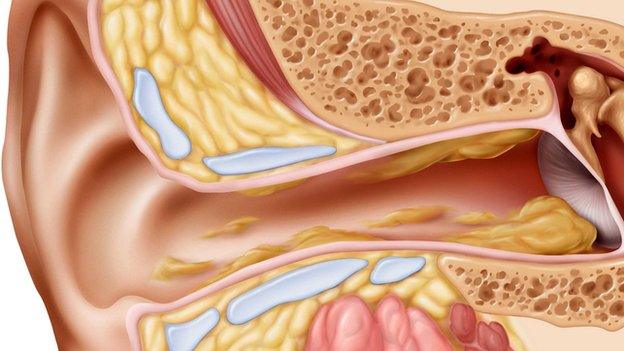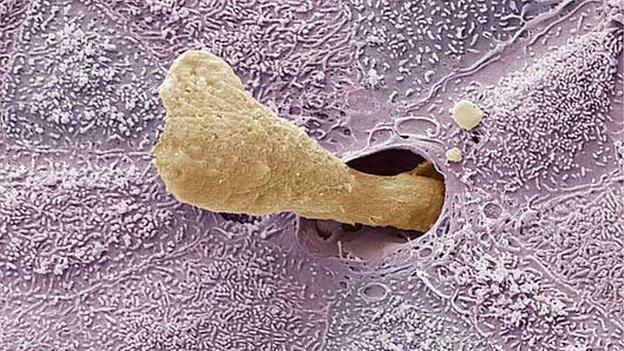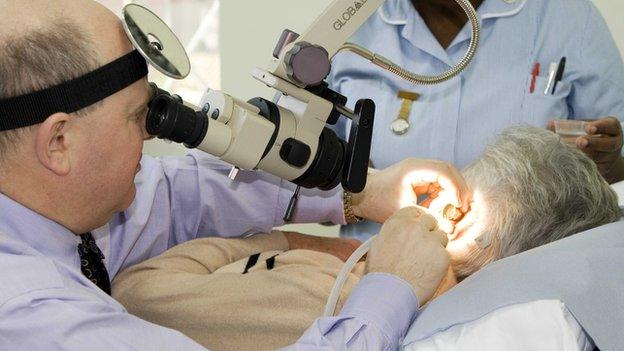Secretion secrets: things you didn’t know about ear wax
- Published

Earwax is one of those bodily substances which few of us like to discuss in polite company.
Like other secretions, it is something that most of us deal with in private. Yet it also holds a fascination for many.
In the past, it has been used as a lip balm and salve for puncture wounds.
But it can do a little more than that. Recent research suggests it can indicate a build up of pollutants in the body - and it could even be used to diagnose certain conditions.
Here are five things you - probably - didn't know about ear wax.
1. How it gets out

The cul-de-sac of the ear canal
The cells inside the ear canal are unique in the human body - they migrate. "You could put an ink dot on the eardrum and watch it move over a few weeks and it would be 'carried out' by the movement of the cells." according to Prof Shakeel Saeed at London's Royal National Throat, Nose and Ear hospital.
If this didn't happen the mini cul-de-sac of the ear canal would soon fill up with dead cells created by the natural process of skin shedding.
This movement also propels the wax - produced by the modified sweat glands which line the ear canal - towards the outside. It's thought that normal movements of the jaw - through eating and talking - assist with this movement.
Prof Saeed has noticed that ear wax does sometimes get darker as we age - and that men whose ears get noticeably hairier as they age sometimes find that the wax can't escape through this jungle of hair.
2. It has anti-microbial properties

Cerumen or ear wax secreted by a gland in the ear canal
Ear wax contains waxy oils but much of it is made up of keratinocytes - dead skin cells. The rest of cerumen - to give it its technical name - is a mixture of substances.
Between 1,000 to 2,000 glands produce anti-microbial peptides - whilst sebaceous glands close to hair cells add into the mix alcohols, an oily substance called squalene, cholesterol and triglyceride.
The production of earwax doesn't vary much between men and women. young or old - but in one small study, external its triglyceride content decreased from November to July.
Cerumen also contains lysozyme, an antibacterial enzyme capable of destroying bacterial cell walls. Other researchers are less convinced and claim that it is the perfect medium in which bacteria can grow.
3. It matters where your family is from

Asian and non-Asian ears produce different types, external of earwax according to scientists at the Monell Institute in Philadelphia. Chromosome 16 is home to the "wet" or "dry" gene for earwax - with the wet variant dominating.
A small change in the gene ABCC11 is related to both the dry-type earwax and also for reduced underarm body odour found in Chinese, Japanese and Korean individuals.
The American study measured the concentration of 12 volatile organic compounds found in earwax - in groups of East Asian and white men.
In 11 out of the 12 compounds the Caucasian earwax had greater amounts of odorous compounds.
Kate Prigge from Monell says their analysis of the smell of ear wax is a first step towards finding out whether they might eventually use it to detect disease.
The institute studies a rare genetic disorder called maple syrup urine disease, which can be easily diagnosed through the scent of earwax compounds. Swabbing someone's ears is a much simpler and cheaper process than doing a genetic test.
Dr Prigge does realise how odd her choice of career might sound. She says: "You tell someone that you work in human body odour you get a good laugh," says Prigge. "But when you explain the importance behind it or how much information can be gained in these types of studies, people often understand why."
4. A vacuum rather than a syringe might help clear it

Carrie Roberts said the procedure was "miraculous"
Carrie Roberts is in her 40s and has an ear wax problem. She had her ears syringed at the GPs several times, tried hot oil with no success - and ended up with both ears blocked.
Ms Roberts decided to pay for micro-suction treatment, where the ear canal is cleaned with an instrument like a tiny vacuum cleaner.
Prof Saeed prefers this method to syringing, external. "With syringing you are going in 'blind' - not under direct vision. If you use water it has to get past the wax and come back, bringing the wax with it.
"If there is no gap it can't get through and it shouldn't be forced. It is uncommon to damage the ear drums during syringing, but it does happen."
With the micro-suction the whole procedure is carried out whilst looking into the ear canal with a microscope.
Carrie said the procedure was "painless, a little noisy and very quick".
She adds: "It felt like one of those things they put in your mouth at the dentist to suck water out while you are having a filling, but in your ear. It has been miraculous."
Carrie is a convert. "I will go every time now. Much better than syringing as I didn't feel dizzy and faint afterwards, it was much quicker and I didn't have to mess about with olive oil for a week first.
5. It can be a pollution monitor

Ear implements from the 1800s
Earwax, like many other bodily secretions, can show traces of certain toxins in the body such as heavy metals. But it's an odd place to look and no more reliable than a simple blood test.
There are also some rare metabolic disorders that affect earwax. The most notable earwax scientific discovery of recent times is that of a 24cm wax earplug from a blue whale, external.
Unlike humans which shed their earwax and dead skin cells, filter-feeding whales retain their earwax, recording life events similar to the way tree rings reveal arid and wet seasons during its lifetime.
The earwax was analysed by Sascha Usenko, a environmental scientist at Baylor University in Waco, Texas. He and his team found that during the 12-year-old male whale's life it came into contact with 16 different pollutants such as pesticides.
There was a peak of exposure during the first year of life - suggesting that these were transferred from its mother either in the womb or through her milk.
High levels of the stress hormone cortisol appeared in the waxy plug as the animal reaches sexual maturity - when competing for a mate would have been a priority.